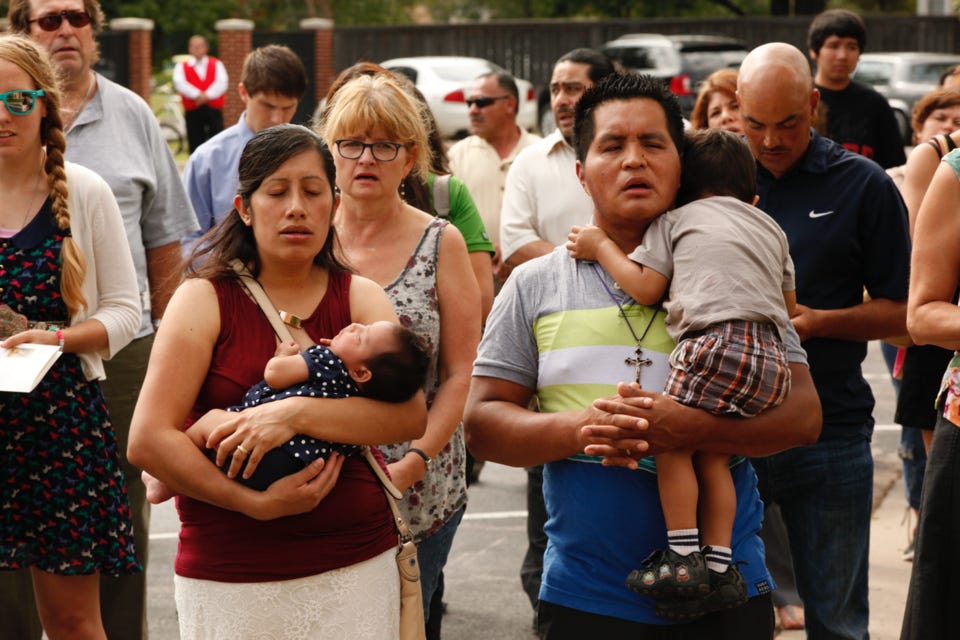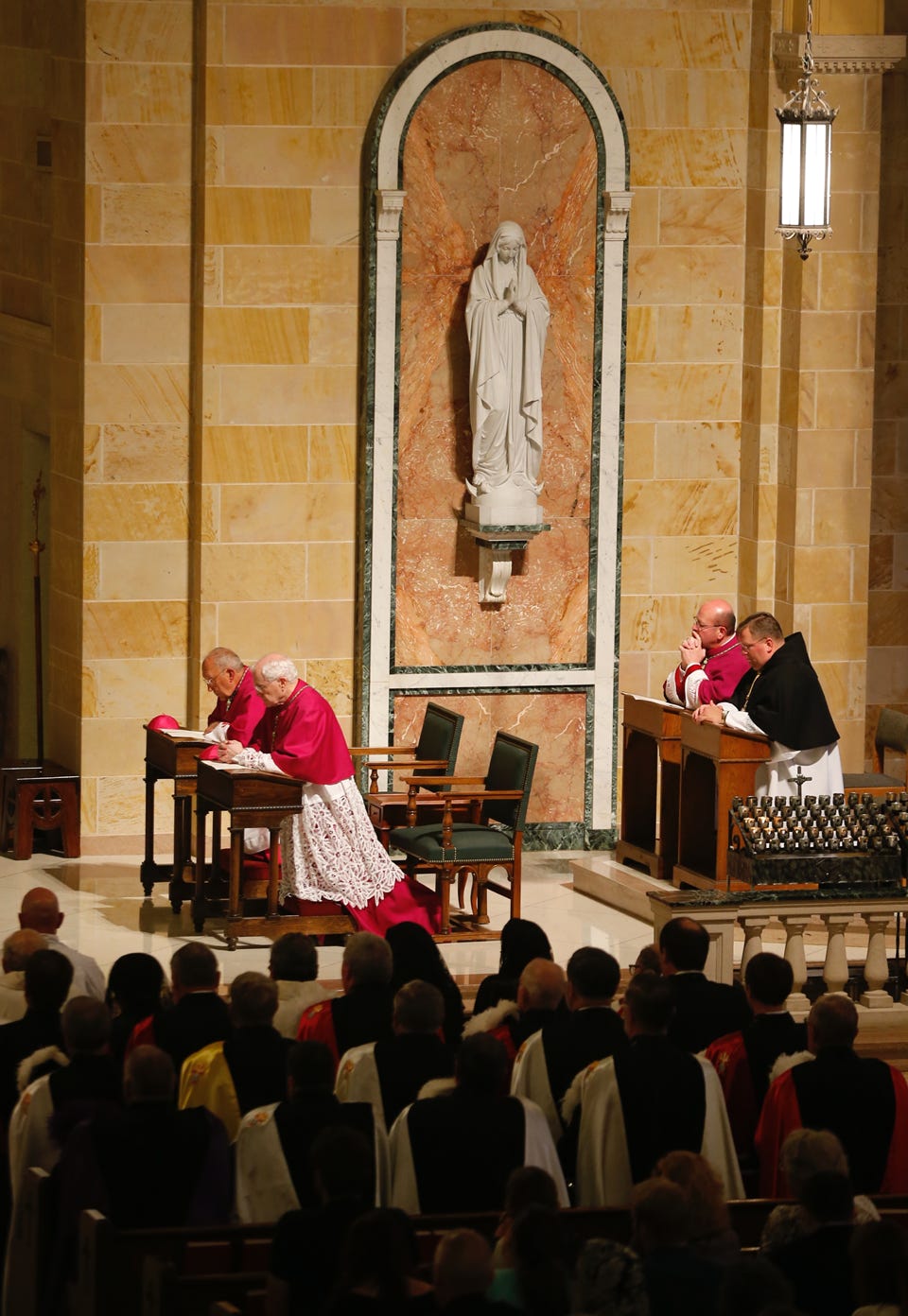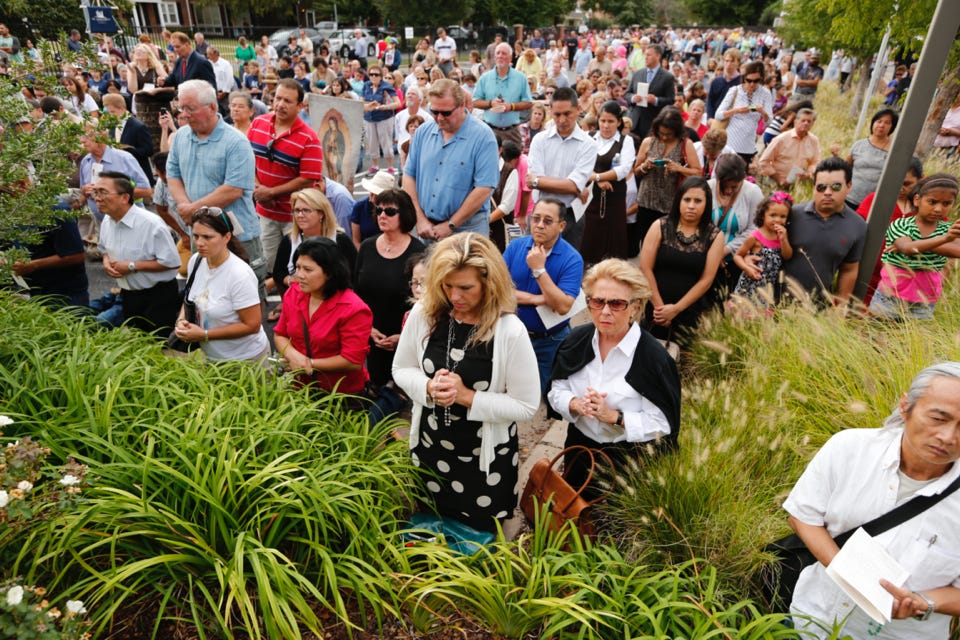“A Beautiful Symphony of Prayer and Adoration”
An Interview with Archbishop Paul S. Coakley
“A Beautiful Symphony of Prayer and Adoration”
An Interview with Archbishop Paul S. Coakley
Archbishop of Oklahoma City, USA
By John Mallon
Archbishop Paul S. Coakley, 59, succeeded the retiring Archbishop Eusebius J. Beltran in 2011 to become the fourth Archbishop of Oklahoma City. This year he ordained the largest class of seminarians to the Archdiocese in over 20 years, with much credit for this going to the earlier work of Archbishop Beltran. But undoubtedly, Coakley’s youth and dynamism also played a large role. He quickly won the hearts of the Oklahoma City Faithful with his warmth and firm proclamation of the Gospel and strong upholding of Catholic teaching.
Yet, nothing has won the hearts of the Faithful more than his firm, bold and public defense of the faith when recently confronted with the specter of a satanic “black mass” held in a municipal entertainment center in Oklahoma City. He spoke out boldly and forcefully against this blasphemous event in a way unprecedented in the modern era, setting a standard for other clergy and bishops who will undoubtedly and increasingly be confronted with this problem in coming years.
He spoke and wrote tirelessly against this evil giving press conferences where he stated the plain Catholic teaching on demonic powers, “These things [demons] are real!” breaking precedent with an unspoken policy long held in the Church, at least in America, of not openly discussing these matters. The result was an overwhelming show of support for him from all parts of the globe and even other churches for his courage and unflinching defense of his flock from the myriad dangers of involvement in demonic activity.
His quick thinking and creativity even forestalled the satanists from desecrating a Consecrated Host at the event, forcing them to return the Host to the Church and proceed with an unconsecrated bread. The result of his actions, despite the fact that the “black mass” did, in fact, go on, was an explosion of faith and support where at least 2,000 people showed up for Benediction, Eucharistic Adoration, and a Eucharistic Procession at a local parish. Similar events were also held in parishes and other dioceses. In this interview, journalist John Mallon, who resides in Oklahoma City, reflected on these events with Archbishop Coakley. The interview was conducted September 30, 2014.
John Mallon: Archbishop Coakley, for at least the last 100 years The supernatural aspects of the Church have been downplayed by many to the point of sweeping them under the rug and even outright denial, especially when it comes to diabolical realities. Yet, you really took this goat by the horns, in a bold and public way, proclaiming these things were real and dangerous. Could you please describe your thinking in taking this approach?
Archbishop Paul Coakley: Well, if we read the Gospels, it’s very evident that one of the primary aspects of Our Lord’s ministry was to exorcise demons, and He had confronted the power of evil head on during His temptation in the desert and throughout His ministry. I think it’s been all too easy, perhaps, at times to downplay the significance of that testimony of Sacred Scripture and our rich history as Catholics.
We didn’t go looking for this challenge. It was a challenge that came to us. I had never heard of a public black mass being offered anywhere in the world prior to May when there was such an attempt at Harvard. When it came to my attention that a group had scheduled the Civic Center here in Oklahoma City, for a public black mass, it didn’t seem like something that I could simply ignore. It took a while to determine the best strategy for responding to that imminent threat. We did not want to bring unnecessary and undue attention to it, figuring that’s precisely what many were seeking. But it was not something that could be ignored so I decided that we would begin to educate people about what was happening, and then come up with our own strategy of prayer and public witness and political pressure to try to put a stop to it.
From a pastoral view, besides the hideous and blasphemous aspects of this ritual, one of the activities described was especially terrifying: that of a supposed “exorcism” of the Holy Spirit, to drive all vestiges of Christianity out of the soul of the participant. It seems the only outcome of such a rite in the willful or ignorant would be outright demonic possession. Would you comment on that?
I had never heard of such an attempt being made. In my understanding of sacramental theology I would question whether it’s even possible. We believe that a baptism, like confirmation and Holy Orders, imprints a sacramental seal, which is indelible, and which we bear with us into eternity. A person falls from grace when they fall into mortal sin. But in terms of some sort of a rite to drive out the Holy Spirit, I don’t know what they are referring to. We lose the indwelling presence of the Holy Spirit when we commit mortal sin, but the sacramental seal remains.
Yes. Well, too, all demons were placed under the authority of the Name of Jesus. I took this alleged “exorcism” to mean a kind of renunciation of Christ and their baptism, which some deluded souls may partake in, but the Holy Spirit is not going to be overcome by some ersatz “rite.”
Exactly. Christ is victorious. Christ has conquered the power of evil, and destroyed the reign of satan in this world. As I mentioned in my homily, the war has been won but the skirmishes continue until Christ comes again in glory. So ultimately we have that confidence that Christ is victorious.
In terms of the Consecrated Host the satanists claimed to be in possession of, it was an elegant and simple solution to sue for its return to the Church as a stolen object. Now the leader of these activities is claiming that a priest in a foreign country supplied the Host to them through the mail. Can you comment?
We heard three or four different stories of where the Host came from. The story seemed to change every time it was reported to us. That was one of the stories we heard. I think they simply didn’t want to say where it had come from. But yes, to answer your question, I had heard that story but I also had heard other accounts about how they had obtained it.
To say the least, it is very disturbing to think of any priest doing that. Wouldn’t that place him, if true, in a state of automatic excommunication?
I think it would certainly make him subject to very severe sanctions, to knowingly provide a Host to a satanic cult for desecration.
The orchestrator of these activities is framing the event as a freedom of religion issue. How do you respond to that?
The world’s religions serve to build up, not to tear down. This cult has no other purpose but to tear down and to mock Catholicism. That doesn’t qualify it as a religion, even though it is steeped in ritual elements. I would deny that it is an authentic form of religion. A story in the Daily Oklahoman described the ritual elements that they used, but he proclaimed openly his intention to bring down the Catholic Church—to destroy the Catholic Church. He fully admitted that was his object. So, I don’t think it can qualify as a question of religious freedom when his whole purpose is to mock and destroy another faith. It contributes nothing positive to the building up of society or strengthening human relations, or contributing to the common good.
How, in your view, could the city officials have banned or refused this event without violating freedom of religion?
We found creative attorneys who helped us find a way to accomplish at least part of what our objective had been, to prevent the desecration of a Consecrated Host. I would have hoped that the city might have had a proportionate concern to stop this from occurring in our community, and sought out legal strategies that might have helped achieve that desired end. I think there would have been other legal strategies to apply other than taking it on as a religious freedom issue, by which they might have defended themselves against that.
You chose to fight fire with glory, as it were, calling not for protest but for prayer in the form of Eucharistic adoration in parishes in reparation and various forms of diocesan-wide prayer, including the recitation of the Prayer of St. Michael at the conclusion of all Masses in the diocese. In such a chaotic a time as ours, do you intend to direct the recitation of the St. Michael Prayer at all Masses continue permanently in the archdiocese?
I had asked that it be prayed at the end of all of our Masses beginning August 4th, the Feast of St. John Vianney, several weeks prior to the scheduled black mass, and to continue until the Feast of the Archangels, September 29th. On the Feast of the Archangels, I sent a letter to our priests encouraging them to continue the use of the prayer. While not mandating it as strongly as I had previously, to be prayed at all Masses in the archdiocese, I encouraged them to use their own pastoral judgment and underlined that this is something that I was strongly encouraging.
It makes you wonder why it was ever dropped. … The response to your call to prayer was tremendous, not only in the archdiocese, but support flowed in on a national and international level, from other bishops, notably our neighboring Bishop Slattery of Tulsa, and the Faithful worldwide. This must have been very gratifying.
It was very gratifying indeed. I had messages from all over the world, from bishops all over the United States. Bishop Carl Kemme of Wichita, was here with several busloads of the Faithful from that diocese, Bishop Edward Slattery of Tulsa was here as well, along with Archbishop Emeritus Eusebius Beltran. I know the diocese of Pittsburgh, in Pennsylvania, had an event simultaneous with ours led by Bishop David Zubik. Those are just anecdotal illustrations of the kind of support that we had and the solidarity we experienced in our efforts to resist this sacrilegious attack on our faith.
I was speaking to a friend in Ireland on Skype, and she said, “Is this that event in Oklahoma City I heard about? Some people asked me to join in praying for Oklahoma City.” I said, “Yes, that’s it!”
Yes! And many of our parishes around the archdiocese had events that day as well. Some parishes of the diocese, obviously, as you know, are pretty far distant from Oklahoma City, so they had their own holy hours and processions in various parts of the diocese. So it was a beautiful symphony of prayer and adoration—throughout the archdiocese, throughout the state, throughout our nation and internationally.
Bishop Slattery of Tulsa released a very moving video [available on YouTube] on the gravity of the situation. The look in his eyes of sorrow and grief was unforgettable. Can you share with us any other gestures of support you received?
Yes, I received letters from priests and members of the Faithful, bishops, from all over the United States, from New Zealand, from Germany, from the United Kingdom, Ireland, Mexico … those are just some that come to mind.
It seems a great sign of the unity of the Church when she is under attack like this, especially with Jesus Christ Himself in the Eucharist under such a vile attack as planned in this ceremony. What have you learned from this experience that you would share with the Faithful, as well as other bishops and priests who could find themselves confronted with a similar situation?
That’s a good question. I think of the words of Saint John Paul II, which became kind of the refrain of his pontificate, “be not afraid!” I think we need to have confidence in the power of the Gospel, and in the Paschal Mystery: Christ has conquered. We are victorious. And we need to claim that victory. I think we need to be innocent as doves, but as clever as serpents.
We need to respond to these threats with all of the appropriate means available to us, but primarily with prayer; but also examining whatever legal means available to us, to claim our right to defend our faith in the public square.
Another thing I want to add, that I didn’t mention among the signs of support: We had good, strong ecumenical support here as well. Initially, when this first came to our attention, and we started talking about it, and I started writing about it, and speaking about it, a lot of people didn’t know what a black mass was.
Here in Oklahoma, we are in the heart of Baptist country, this is the Bible Belt. So people aren’t accustomed to a kind of sacramental economy, if you will, and the liturgical tradition. I don’t think many people really understood why I was raising this alarm, because they didn’t really understand what the Mass is, perhaps. But I think the more we talked about it and wrote about it, the more people came to understand that this was an attack not only upon the Eucharist, which is at the heart of our Catholic faith, but on the foundations of Christian belief for all Christians. So, many other church leaders throughout our community expressed their solidarity with us, wrote their letters of support, from all across the spectrum. It was very gratifying to see the various churches and ecclesial communities come together.
Even without necessarily understanding the Eucharist, they seemed to want to come to the defense of Jesus, and their brothers and sisters in the Catholic Church.
Exactly. Exactly. They could sense this was really a battle between light and darkness, and good and evil.
Is there anything else you’d like to add?
Diane Clay (Archbishop Coakley’s Communications Director who was present for the interview): I think it also gave us an opportunity to talk about parts of our faith, like the rosary, which weren’t well understood.
Archbishop Coakley: Yes! Thank you, Diane. One of the fruits of this has really been, that as Catholics in Oklahoma, we have found a platform and a profile in the public square that we are not accustomed to. I gave innumerable interviews, not only with religious media, but with secular media as well. It was an opportunity to talk about the Eucharist. To talk about the Mass. To talk about Jesus. To talk about satan. To talk about the Gospel. To talk about St. Michael the Archangel! The Consecrated Host. It was an opportunity for evangelization, and catechesis, and for inviting people to prayer—and conversion.
Authors note: In the past year (2019-2020 Archbishop Coakley directed the prayer of St. Michael be recited ant the end of every Mass in the Archdiocese.
—
John Mallon served as editor of the Sooner Catholic, the archdiocesan newspaper of the Archdiocese of Oklahoma City, from 1994—1997. The Sooner Catholic won 11 journalism awards under his watch. At that time he also served as communications director and media spokesman for Archbishop Eusebius Beltran.
Photos of the crowds inside and outside the church for the Eucharistic adoration and procession courtesy of the Archdiocese of Oklahoma City/Steve Sisney, with special thanks to Diane Clay. Photo at the top of Archbishop Coakley by John Mallon




